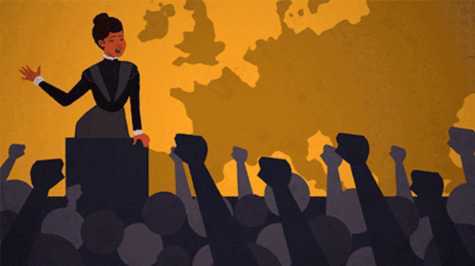Intersectionality in Women’s Rights
March 15, 2021
#bidenerasedwomen: a hashtag condemning yet another misogynistic politician for enacting a law encroaching on women’s rights? Or a hashtag revealing the continuing lack of intersectionality in feminism in today’s society?
On January 20th of this year, President Biden signed an executive order in support of transgender individuals–protecting them from discrimination based on their sexuality and enabling agencies to alter their facilities and policies to include transgender individuals based on the Supreme Court Bostock v. Clayton County ruling. Essentially, the ruling stated that discrimination against LGBTQ+ individuals overlaps with already prohibited forms of discrimination, like discrimination based on race and disability. This could mean, depending on the agency, the elimination of gendered restrooms or locker rooms, including transgender individuals on gendered teams that do not match the sex they were assigned at birth, and requiring gendered shelters to include transgender individuals. Certain feminists consider this a violation of women’s rights, as the order allows biologically male individuals into what they consider “refuges and safe spaces.” Evidently, the women’s rights these feminists are fighting for exclude the rights of certain women–a phenomenon that has persisted for over a century.
One of the greatest examples of a lack of intersectionality within women’s rights is the racism within the suffrage movement in the late 19th century and early 20th century, from which we remember notable white women, such as Alice Paul and Elizabeth Cady Stanton. While these two women undeniably had a great impact on women’s rights, the fact that most people’s knowledge of suffragists stops at these women is problematic–both because activists of color are forgotten and because a significant portion of middle-class white people who supported the suffragist movement in the 20th century worked to secure white supremacy by neutralizing black votes. African American activist Ida B Wells faced this lack of intersectionality when she attempted to join the protest at Woodrow Wilson’s inauguration and was told to leave because of the color of her skin. This well-known writer, known for her work with organizing anti-lynching campaigns, is just one of many who faced similar discrimination.
the late 19th century and early 20th century, from which we remember notable white women, such as Alice Paul and Elizabeth Cady Stanton. While these two women undeniably had a great impact on women’s rights, the fact that most people’s knowledge of suffragists stops at these women is problematic–both because activists of color are forgotten and because a significant portion of middle-class white people who supported the suffragist movement in the 20th century worked to secure white supremacy by neutralizing black votes. African American activist Ida B Wells faced this lack of intersectionality when she attempted to join the protest at Woodrow Wilson’s inauguration and was told to leave because of the color of her skin. This well-known writer, known for her work with organizing anti-lynching campaigns, is just one of many who faced similar discrimination.
 The conflict between transgender women and cisgender women, women who were assigned the gender they identify with at birth, within women’s rights movements has existed since at least the 1970s, during the time of the civil rights movement. The conflict stems from the belief that transgender women are not “real” women, simply because their biology at birth did not match their gender. In the late 20th century, transgender women faced discrimination in the form of being barred from women-only events, like the Michigan Women’s Music Festival, and being publicly shamed at LGBTQ and women’s rights events, like singer Beth Elliot was at the first National Lesbian Conference. Today, transgender women and activists face allegations of lesbian erasure, a concept that certain radical lesbian feminists define as the encouragement of lesbians to transition into straight men, and the idea that the transgender movement is misogynistic and anti-lesbian. Several lesbian catering media outlets have distanced themselves from this idea, essentially condemning it as transphobic.
The conflict between transgender women and cisgender women, women who were assigned the gender they identify with at birth, within women’s rights movements has existed since at least the 1970s, during the time of the civil rights movement. The conflict stems from the belief that transgender women are not “real” women, simply because their biology at birth did not match their gender. In the late 20th century, transgender women faced discrimination in the form of being barred from women-only events, like the Michigan Women’s Music Festival, and being publicly shamed at LGBTQ and women’s rights events, like singer Beth Elliot was at the first National Lesbian Conference. Today, transgender women and activists face allegations of lesbian erasure, a concept that certain radical lesbian feminists define as the encouragement of lesbians to transition into straight men, and the idea that the transgender movement is misogynistic and anti-lesbian. Several lesbian catering media outlets have distanced themselves from this idea, essentially condemning it as transphobic.
In the end, #bidenerasedwomen comes from a similar place. Rather than the bill being an attack on women’s rights, it could be considered as an attempt to uplift fellow women who were unable to even go to the restroom of the gender they identify as. It can also serve as a reminder of how one can face discrimination within a human rights movement, as well as a call to action to eliminate such discrimination in human rights movements today.

